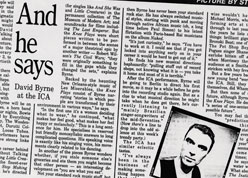ORIGINAL
PRESS CLIPPINGS

Pageant: Portion of Robert Wilson's ‘Civil Wars’
For now, at least, the United States has lost the chance to present the complete version of Robert Wilson's grandiose theatrical pageant “The Civil Wars: A Tree Is Best Measured When It Is Down.” The playwright, director and designer has been assembling the separate sections of this work around the world over the last couple of years, but the scheduled performances this June in Los Angeles were canceled late last month by the Olympic Arts Festival for lack of financing.
The only portion of “The Civil Wars” actually to be sponsored and presented by this country had its premiere here Thursday night. The production, which is called “The Knee Plays,” was the first collaboration between the Guthrie Theater and the Walker Art Center, and it was staged in the small Walker Art Center auditorium.
Some of the self-contained, interlocking scenes of “The Civil Wars” could be called “theater,” some “dance” and some “opera.” They employ different composers, choreographers and other collaborators, but all were meant from the first to be part of a larger whole that could last as long as 14 hours. Mr. Wilson uses the term “knee plays” to describe his entre'actes, which function as joints between the larger scenes. All told, there are five acts in “The Civil Wars,” with each of the 16 scenes lasting up to an hour.
The 13 “knee plays” are meant to snake through the larger scenes, playing before the curtain as the scenery is changed, telling their own story, but also commenting on and introducing imagery in coming scenes. With the “knee plays” linked together and joined by their own brief interludes, the Minneapolis performance ran just under two hours.
All of Mr. Wilson's work shies free of a simply tellable “story” or even a precisely quantifiable set of meanings and metaphors. He works in recurrent images and symbols, the import of which may or may not strike an observer as meaningful; for many, they strike very deep indeed.
Nonetheless, the Amsterdam, Cologne, Rome and, now, Minneapolis productions have revealed some of the visions that inspired Mr. Wllson. He began with Matthew Brady's photographs of the American Civil War and photos of Japan in the period immediately following its abrupt Westernization. From there, he worked outward, adapting imagery from the countries planning productions and from the byways of his mind. There are polar bears and spaceships, owls and Abraham Lincoln, Garibaldi and tulips, ladders to heaven and Hercules founding the Olympic Games. His “civil wars” seem to be all conflicts that divide mankind, with the Olympics as the concluding symbol of reconciliation.